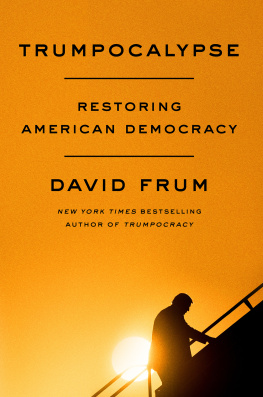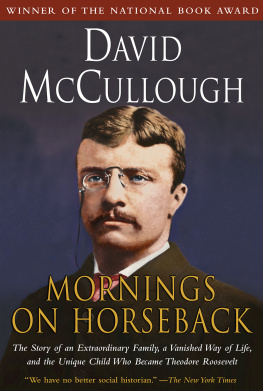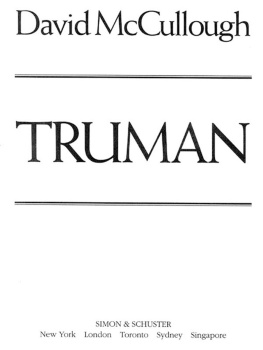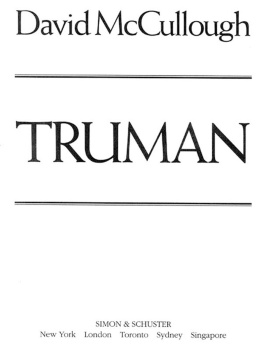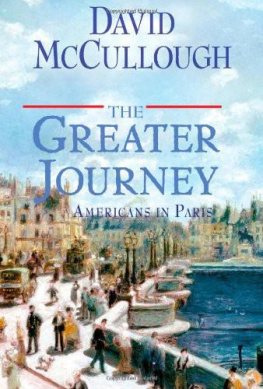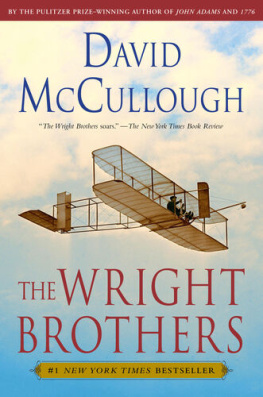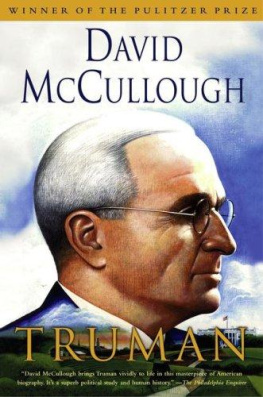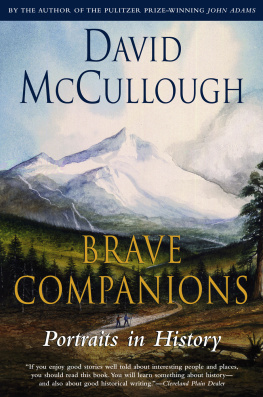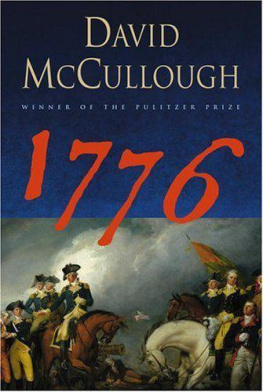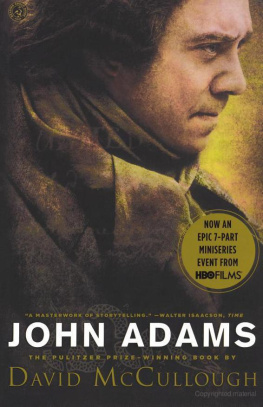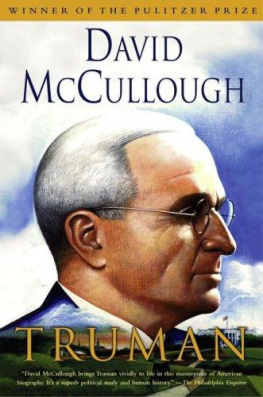Thank you for downloading this Simon & Schuster eBook.
Join our mailing list and get updates on new releases, deals, bonus content and other great books from Simon & Schuster.
C LICK H ERE T O S IGN U P
or visit us online to sign up at
eBookNews.SimonandSchuster.com
Contents
For Rosalee Barnes McCullough
Introduction
T HERE IS a story that goes with the painting of Theodore Roosevelt by John Singer Sargent that hangs in the White House.
Sargent, it is said, had been waiting about the mansion for several days, hoping for a chance to see the president and talk to him about doing his portrait, when one morning the two met unexpectedly as Roosevelt was descending the stairway.
When might there be a convenient time for the president to pose for him, Sargent asked.
Now! said the president.
So there he is in the painting, standing at the foot of the stairs, his hand on the newel post. It is a great portrait, capturing more of the subtleties of the Roosevelt personality than any ever done of him.
And its a good story. Moments come and go, the president was telling the painter. Here is the time, seize it, do your best.
My earliest ambition was to be an artist. When I was ten or so, our art teacher at Linden School in Pittsburgh, Miss Mavis Bridgewater, demonstrated two-point perspective on the blackboard, and it seemed to me a miracle. I dont think I would have been much more amazed had she caused her desk to levitate.
I began to draw and paint. At Yale later, though an English major, I studied under an artist named Dean Keller, who, because of the rather old-fashioned portraits he did (largely for the university of its prominent professors) and his insistence on understanding anatomy, was anathema in a department then dominated by Joseph Albers, the German cubist known for his paintings of squares. I wanted to be a portrait painter.
As a writer I am still drawn to the human subject, to people and their stories, more often than to large current issues or any particular field of academic inquiry. The explorer interests me more than geography, the ichthyologist more than his fish, Theodore Roosevelt before, say, the Progressive Movement.
Nor have I ever been able to disassociate people or stories from their settings, the background. If character is destiny, so too, I believe, is terrain.
Seeing how the light falls in a marble room on Capitol Hill, or smelling the coal smoke in the air on a winter night in Pennsylvania, helps in making contact with those who were there before in other days. Its a way to find them as fellow human beings, as necessary as the digging you do in libraries.
At times Ive not known for certain whether I wanted to go ahead with a story until I have been where it happened.
The sun was scorching hot and we should have had hats, but we dipped our hands in the water and the farther we went the cooler it got and especially when we hit the rapids, I read now in a letter I wrote to my wife from Panama years ago, after a first reconnaissance of the Chagres River wilderness made in a dugout canoe with two young sons, two Cuna Indians, and an American hydrologist, Frank Robinson, who knew the names of every tree, most birds and insects, and all about the stupendous cycle of Panama rainfall. A day or two in such country goes far in stirring your sympathy and admiration for those intrepid souls, the pioneer builders, who came there in the last century, first to build a railroad.
Surroundings are essential to contemporary subjects no less. To spend time with someone like Miriam Rothschild in the fervently bizarre atmosphere of the family estate north of London, for example, or to follow David Plowden through the cornfields and small towns of Illinois, is for me the only way to see them clearly.
So the portraits here are often figures in a landscape.
Most of these essays were written for magazines. That they might one day be companion pieces in a book was a thought that never occurred at the time. Each was an individual undertaking. Several of them, for reasons personal or professional, had to be done on short notice, Now, as Roosevelt said. They were produced over a period of nearly twenty years, at very different times in my life, and about subjects as dissimilar as Alexander von Humboldt and Conrad Richter. Two of the stories, one set in Panama, the other in the Badlands of North Dakota, resulted from research I was doing for books. Another represents a return to a subject I had already covered in a book, but about which I found I had some new things to say. It was written as a way of honoring the 100th birthday of the Brooklyn Bridge.
In the final section, Ive included two speeches written for such different occasions as a college commencement in Vermont and the ceremonies celebrating the bicentennial of the United States Congress.
Yet I find my subjects are more closely connected than I knew. Reading these essays again, selecting and arranging them as a book, I am struck by how much they have in common. In my way, I see now, I have been writing about the same kinds of people all along. And I see, too, the extent to which they have revealed the world and times past for me, and things about myself, that I would not have known otherwise.
Because of the ichthyologist, the incomparable Louis Agassiz, I was introduced not only to his world of fish, but to his way of seeing.
Look at your fish! Agassiz admonished his students in what for me remains one of the most valuable of all lessons. Look at your fish! are the words of the small, framed reminder Ive since kept by my desk: discoveries are as likely to be found in material already in hand, before your eyes, as anywhere.
Agassiz was one of the greatest of the great teachers of the nineteenth century. His influence reverberates down to our own day. But then its fair to say my subjects are nearly all teachers. They are writers, civil engineers, men and women of science, aviators, wives and mothers, politicians. One of them, Frederic Remington, is a painter and sculptor; another, Harry Caudill, is a small-town lawyer; David Plowden is a photographer. Yet each in his or her own way is teaching us to see, and to experience the exhilaration, or magic, or outrage, or understanding they feel from what they see.
What a grand and solemn spectacle! The very sight of it renewed our strength, writes Humboldt of the moment in 1802 when, exhausted, gasping for air at an elevation of nearly fifteen thousand feet, he and his partner, Aime Bonpland, catch a sudden glimpse through the clouds of the summit of Mount Chimborazo.
My microscope is my marijuana, says Miriam Rothschild, who in many ways is Humboldts present-day counterpart.
I dont think that the men at the top of those enormous corporations are wicked men, observes Harry Caudill as he and I survey the ravages of strip mining in his native Letcher County, Kentucky. But you know theres not a one of them that has been down here to see things with their own eyes, to see what is going on here. Not one. And yet the decisions they make have everything to do with how we live here.
Harriet Beecher Stowe sees the evil of slavery and sees her duty plain. From the vantage point of the airplane, Charles and Anne Lindbergh and their fellow pioneer aviators, Antoine de Saint-Exupry and Beryl Markham, begin to understand their place in the large order of things.
Finding my subjects over the years has been mostly a process of one thing leading to another. Reading about Henry Ward Beecher, as a way to understanding what life was like on Brooklyn Heights at the time the Brooklyn Bridge was being built, I came upon his sister Harriet, as described in Constance Mayfield Rourks vivid book, The Trumpets of Jubilee. Reading about early explorations of Central America for background on Panama, I encountered Humboldt for the first time, and research for an article on Humboldt led me to Agassiz, one of whose star students, Nathaniel Southgate Shaler, was Theodore Roosevelts professor of geology at Harvard. It was to understand Roosevelt and his time in the Badlands that I looked into the life and influence of Remington. And so it has gone.


